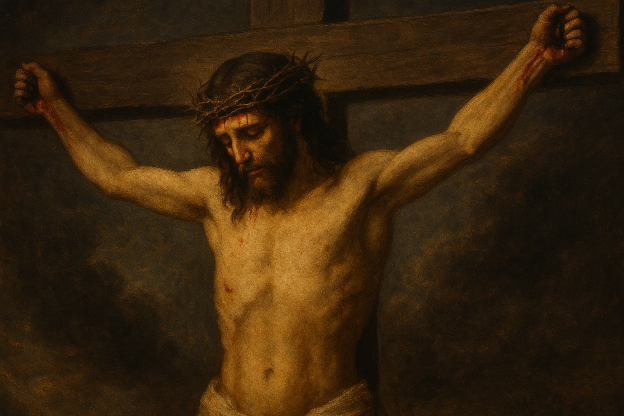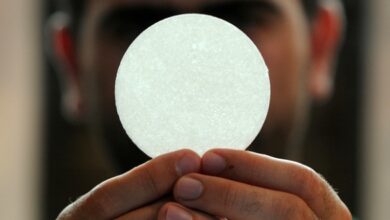The Power of the Cross: A Love That Changed the World Forever

Please press the Play button below to listen to this discussion.
The Power of the Cross: A Love That Changed the World Forever
Each year during Holy Week, the Church draws us into the most sacred and transformative moments of human history. This year’s readings for the Passion of Christ—beginning with the Suffering Servant in Isaiah, continuing through Saint Paul’s reflection in Philippians, and culminating in the harrowing Gospel account of Christ’s betrayal, trial, crucifixion, and death—offer not only a retelling of past events but an invitation to gaze once again at the mystery of a God who chose a cross to save His people.
This is not myth. This is not mere tradition.
This is history. And this is everything.
Who Is Jesus?
Before we can reflect on the Cross, we must answer this: Who is Jesus?
Jesus is God made flesh—Emmanuel, “God with us” (Matthew 1:23). He did not cling to His place in the glory of heaven, but as Philippians 2:6-8 tells us, “though He was in the form of God, did not regard equality with God something to be grasped. Rather, He emptied Himself, taking the form of a slave, coming in human likeness…”
He is not a prophet who died for a cause.
He is not merely a teacher who lived a good life.
He is the Son of God, eternally one with the Father and the Spirit, who came not to be served but to serve and to give His life as a ransom for many (Mark 10:45).
Jesus Christ was born to die. And in dying, He conquered.
Why Did Jesus Come Into This World?
To fully grasp the power of the Cross, we must take a step back—to the very beginning.
In Genesis, we are told that humanity was created in the image and likeness of God. Adam and Eve were formed not merely as creatures but as children, entrusted with dominion over creation and invited into a relationship of love, obedience, and union with God. But that relationship was shattered.
Through disobedience, sin entered the world—and with sin came death, not only physical but spiritual: the severing of communion with God.
“By one man sin entered into the world, and death through sin, and so death spread to all men because all sinned.” (Romans 5:12)
But even at that darkest moment, God did not abandon humanity.
In fact, He made a promise.
In Genesis 3:15, often referred to as the Protoevangelium—the first gospel—God declared that one day the offspring of the woman would crush the head of the serpent. This was not poetic symbolism. It was a prophecy of what was to come—a divine pledge that God Himself would make a way back for humanity.
From that moment forward, all of Scripture becomes the unfolding of a rescue plan.
Why Did God Send His Son?
It is almost unfathomable. That God, infinite in majesty, would look upon a world so marred by rebellion, idolatry, violence, perversion, and pride—and yet, instead of wiping it away, He chose to enter into it.
“For God so loved the world that He gave His only begotten Son, so that everyone who believes in Him might not perish but might have eternal life.” (John 3:16)
God did not send His Son to condemn the world. He sent Him to save it. (John 3:17)
But save it from what?
From the power of sin, which held the world in slavery.
From the penalty of sin, which is death.
From the presence of sin, so that we might one day live in perfect communion with God again.
Jesus: The Fulfillment of the Promise
Jesus did not appear randomly in time. He came “in the fullness of time” (Galatians 4:4), when God had prepared the world and His people to receive the Messiah.
At His birth, the angel declared:
“You shall name Him Jesus, because He will save His people from their sins.” (Matthew 1:21)
That was His mission.
Not to overthrow Rome.
Not to establish a worldly kingdom.
But to defeat sin at its root.
The entire Old Testament—its prophecies, covenants, priesthood, temple, and sacrifices—pointed forward to this fulfillment.
The Problem of Sin and the Need for Sacrifice
Under the Old Covenant, priests offered sacrifices again and again—bulls, goats, and lambs—yet the power of sin remained. Hebrews 10:4 says, “It is impossible for the blood of bulls and goats to take away sins.”
These were signs—preparations for the true Sacrifice to come.
The world needed a perfect, spotless lamb.
The world needed a sinless man who could stand in our place.
The world needed a High Priest who would not only enter the temple with a sacrifice but would offer Himself.
That’s who Jesus is.
John the Baptist cried out when he saw Him:
“Behold the Lamb of God, who takes away the sin of the world!” (John 1:29)
He is both Priest and Victim.
“He entered once for all into the holy places… by means of His own blood, thus securing an eternal redemption.” (Hebrews 9:12)
This is why Jesus had to come—not simply to teach or to heal, though He did both. He came to die.
And in dying, He broke the chains of sin forever.
The Mystery of Love
This is what makes the Cross so mind-blowing.
God did not just send a prophet.
He did not send an angel.
He came Himself, in the Person of the Son.
This wasn’t just about fixing a problem. It was about restoring a relationship—at the highest cost imaginable.
“God proves His love for us in that while we were still sinners, Christ died for us.” (Romans 5:8)
This is the Gospel.
This is grace.
And this is why the Cross stands at the center of history.
The First Reading: The Suffering Servant (Isaiah 52:13—53:12)
This prophetic text from Isaiah is among the most startling in the Old Testament. Written centuries before Jesus’ birth, it foreshadows in vivid detail the agony of the Messiah:
“He was spurned and avoided by men, a man of suffering, accustomed to infirmity… pierced for our offenses, crushed for our sins.”
The world often recoils at suffering, seeing it as meaningless. But here, God reveals a suffering that redeems. Jesus bore our sins—not in a symbolic way, but in a real, tangible, painful way. Every scourge, every nail, every drop of blood was for us.
This Servant was not punished for His own wrongdoing. He was sinless. He was punished in our place—the innocent for the guilty.
The Responsorial Psalm: “Father, into Your Hands I Commend My Spirit” (Psalm 31)
The words of this Psalm, spoken by Jesus at the moment of His death (Luke 23:46), encapsulate the total trust Jesus had in the Father. Even when betrayed, scourged, humiliated, and dying, Jesus surrendered completely.
Can we do the same?
In a world that urges self-preservation and distrust, Jesus shows the power of surrender, not as weakness but as the highest act of strength and love.
The Second Reading: Philippians 2:6–11
This is one of the oldest known Christian hymns. It proclaims the divine humility of Jesus, who “humbled Himself, becoming obedient to death, even death on a cross.”
But it does not end in death.
“Because of this, God greatly exalted Him… that at the name of Jesus every knee should bend… and every tongue confess that Jesus Christ is Lord.”
This is the paradox of the Cross: it is the road to glory. Jesus was not defeated. He was exalted, and through Him, we too are offered eternal life.
The Gospel: The Passion of Our Lord
Whether we hear it from Matthew, Mark, Luke, or John, the Gospel account of the Passion is deeply emotional, soul-piercing, and sacred.
This year’s Gospel (John 18–19) brings out the divine control Jesus had, even in His betrayal and arrest. When the soldiers approached and He said, “I AM,” they fell to the ground. It echoes the divine name revealed to Moses—YHWH. Even in chains, Jesus is Lord.
We follow Him through the mock trial, the beating, the carrying of the cross, and the crucifixion. The details are brutal. But they are not gratuitous. They are necessary—because sin is brutal.
At the height of His suffering, Jesus cried out, “It is finished.” (John 19:30) He wasn’t announcing defeat—He was declaring victory. The mission was complete. The price was paid. The door to salvation had been thrown open for every soul who would believe.
Why It Matters Today
This isn’t just ancient history. The cross remains the center of human redemption. Every injustice, every war, every broken heart, every addiction, every death—all are answered at the cross.
We live in a world scarred by sin. From the violence in our streets to the disintegration of families, from the rise in anxiety and despair to the turning away from God—the world is wounded.
And still, Jesus speaks:
“Come to Me, all you who are weary and burdened, and I will give you rest.” (Matthew 11:28)
The Cross is not just something we remember. It is something we must embrace. It’s the only place where justice and mercy meet perfectly. It’s where love poured itself out without holding anything back.
And it demands a response.
A Call to Action: What Will You Do With the Cross?
You have heard the story.
You know the price that was paid.
You know who Jesus is—not just a man, but God Himself—who came down for you.
So the question now is:
Will you follow Him?
Will you turn away from sin and walk the road of love, mercy, and truth?
Will you pick up your cross and carry it, knowing that Jesus walks with you?
Will you surrender your heart fully—not just part of it—to the One who gave His life for you?
Don’t let this Holy Week pass as just another tradition.
Don’t let the Cross be a distant symbol.
Let it be your hope, your anchor, your salvation.
Come back to Jesus. Fall at the foot of the Cross and receive the gift of new life.
Because the truth is: He died for you.
And more than that—He rose for you.
And He’s coming again.
Now is the time to believe.
Now is the time to live for what truly matters.
Now is the time to let the power of the Cross change your life forever.






